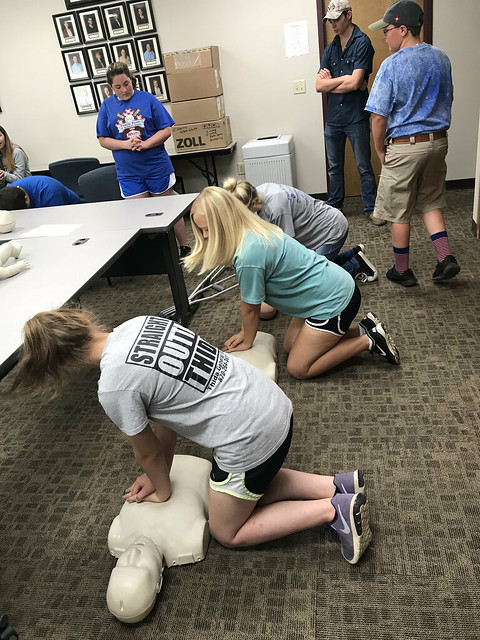Four steps to emergency preparedness
By Emily Thompson
U of A System Division of Agriculture
Sept. 14, 2018
Four steps to emergency preparedness
Fast Facts:
- September is emergency preparedness month
- Create emergency supply kits and communication plans for your family in case disaster strikes
- The MyPI program trains teen in disaster preparedness skills
(669 words)
Download related PHOTOS from Flickr: https://flic.kr/s/aHsms1Yrvy
LITTLE ROCK —Hurricane Florence is not projected to directly impact Arkansas, but as the storm makes its way to the east coast of the U.S., it serves as a reminder to make sure your family is prepared for emergencies.

September is National Emergency Preparedness Month. Throughout the month, FEMA encourages households to create an action plan in case emergency strikes.
“It is actually fairly simple for a family to be prepared for an emergency,” said Ashley Dingman, MyPI Arkansas Coordinator and University of Arkansas Cooperative Extension 4-H Program Associate.
The MyPI program, or the My Preparedness Initiative, teaches teens disaster preparedness skills.
Dingman said getting a household ready for an emergency can be boiled down into four steps.
“First, get a kit of emergency supplies ready and make sure the kit is maintained,” Dingman said. The kit should contain enough supplies to sustain a family for at least three days and be kept in a safe, easily accessible location.
Kit staples include non-perishable food, battery powered radio, batteries and flashlights. The emergency kit should also include one gallon of water per person, per day for drinking and sanitation. Be sure to consider your family’s unique needs when making an emergency kit. Include any prescription medications, baby supplies or important documents your family might need.
The second step is to develop a communication plan. When an emergency occurs, your family might not all be together.
“Consider a plan where each family member contacts the same friend or relative in the event of any emergency,” Dingman said. “This way, no one gets confused during a stressful time.”
Dingman also said that in certain emergency situations it is easier to receive long distance calls than local ones, so having an out-of-town contact might be a good option.
Families should also formulate a getaway plan. Pick several locations in different directions so you have multiple viable options if you need to evacuate. Be sure to know the emergency policies of the schools and workplaces for each family member. These policies could affect your getaway and communication plans.
The third step is to stay informed.
Dingman said some emergencies, like certain weather events, are known about in advance. In that case, implement your communication and getaway plan.
But some emergencies occur with no warning.
“We all know that there is the potential for manmade disasters and in those cases, you have to be informed about the specific threat before you can act,” Dingman said. “FEMA suggests visiting www.ready.gov to learn more about potential manmade emergencies and how to adapt that information to your area.”
The fourth and final step to emergency preparedness is to get involved in your community.
“After preparing your immediate family, take the next step and get involved in helping to prepare your community. If your community is better ready to handle an emergency – both natural and manmade – then your family will be better equipped,” Dingman said.
The MyPI program puts an emphasis on community disaster preparation. As part of the 5- to 10-week course, teens create emergency kits for their family and six other households. They will also become Community Emergency Response Team certified.
MyPI is currently offered in six counties and Dingman plans to expand into more counties. By July of 2019, Arkansas will have graduated 125 MyPI students who will have 875 emergency supply kits for their communities.
Recommended supplies for a basic emergency kit
- Water: one gallon per person per day for drinking and sanitation
- Food: 3+ day supply of non-perishable food
- Battery powered radio and extra batteries
- Flashlight and extra batteries
- First Aid kit
- Whistle (to signal for help)
- Filter mask or cotton t-shirt to help filter the air you breathe
- Moist towelettes for sanitation
- Wrench or pliers to turn off utilities
- Manual can opener (if your food supply contains cans)
- Plastic sheeting and duct tape for a shelter
- Garbage bags and plastic ties for sanitation
For more about emergency preparedness, visit, https://www.uaex.uada.edu/life-skills-wellness/emergency-preparedness.aspx. For more information about the MyPI program, contact your local county extension agent.
About the Division of Agriculture
The University of Arkansas System Division of Agriculture’s mission is to strengthen agriculture, communities, and families by connecting trusted research to the adoption of best practices. Through the Agricultural Experiment Station and the Cooperative Extension Service, the Division of Agriculture conducts research and extension work within the nation’s historic land grant education system.
The Division of Agriculture is one of 20 entities within the University of Arkansas System. It has offices in all 75 counties in Arkansas and faculty on five system campuses.
Pursuant to 7 CFR § 15.3, the University of Arkansas System Division of Agriculture offers all its Extension and Research programs and services (including employment) without regard to race, color, sex, national origin, religion, age, disability, marital or veteran status, genetic information, sexual preference, pregnancy or any other legally protected status, and is an equal opportunity institution.
Media Contact: Mary Hightower
Dir. of Communication Services
U of A Division of Agriculture
Cooperative Extension Service
(501) 671-2126
mhightower@uada.edu
Related Links